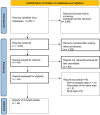Efficacy of transversus abdominis plane block on postoperative nausea and vomiting: a meta-analysis of randomized controlled trial
- PMID: 38429757
- PMCID: PMC10905943
- DOI: 10.1186/s12871-024-02469-x
Efficacy of transversus abdominis plane block on postoperative nausea and vomiting: a meta-analysis of randomized controlled trial
Abstract
Background: Postoperative nausea and vomiting (PONV) is a common postoperative complication, and Transversus abdominis plane (TAP) block can provide effective analgesia for surgical operation. However, but there is not enough evidence to prove its advantage for nausea and vomiting. The objective of this meta-analysis was to evaluate the efficacy of TAP block on PONV.
Methods: Two independent researchers conducted searches for randomized controlled trials (RCTs) in PubMed, Embase, and Cochrane Central Register of Controlled Trials. We used Review Manager software for meta-analysis.
Results: In this meta-analysis, twenty-six trials with 1981 patients were examined. The results showed that TAP block reduced postoperative nausea (Risk Difference (RD) = -0.10, 95% confidence interval (CI): -0.15 to -0.05) compared with no TAP block. TAP block reduced the dose of fentanyl (Standardized Mean Difference (SMD) = -1.17, 95% CI: -2.07 to -0.26) and morphine (SMD = -1.12, 95% CI: -2.10 to -0.13) compared with no TAP block, when the timing of administration was before surgery (RD = -0.13, 95% CI: -0.19 to -0.07). TAP block reduced postoperative nausea when the ropivacaine dosage is ≤ 100 mg (RD = -0.13, 95% CI: -0.21 to -0.06), bupivacaine dosage ≥ 100 mg ( RD = -0.08, 95% CI: -0.13 to -0.03), and when the ropivacaine concentration was ≤ 0.375% (RD = -0.11, 95% CI: -0.18 to -0.04). TAP block significantly reduced the incidence of nausea when the types of opioid drugs in PCA is tramadol (RD = -0.13, 95% CI: -0.24 to -0.03). TAP block could reduce the VAS (SMD= -0.99, 95% CI: -1.29 to -0.70) and reduce the time of extubation (SMD = -0.71, 95% CI: -1.34 to -0.08).
Conclusion: The meta-analysis conducted in this study revealed that TAP block could reduce the incidence of PONV, and the efficacy of TAP block may be influenced by factors such as administration time, local anesthetic dosage and concentration, types of opioid drugs in PCA.
Keywords: Meta-analysis; Nausea; Transversus abdominis plane; Vomiting.
© 2024. The Author(s).
Conflict of interest statement
The authors declare no competing interests.
Figures






References
-
- Labafchi A, Shooshtari Z, Grillo R, Sharifian Attar A, Eshghpour M, Samieirad S. The Beneficial Effect of Preoperative Dexmedetomidine in Controlling Postoperative Pain, Nausea, and Vomiting after Orthognathic Surgery: A Triple-Blind Randomized Clinical Trial. Journal of oral and maxillofacial surgery: official journal of the American Association of Oral and Maxillofacial Surgeons (2023). 10.1016/j.joms.2023.04.014. - PubMed
-
- Chen P, Du R, Chang Z, Gao W, Zhao W, Jin L, et al. The risk factors of postoperative nausea and vomiting in patients undergoing laparoscopic sleeve gastrectomy and laparoscopic distal gastrectomy: a propensity score matching analysis. Sci Rep. 2023;13(1):7866. doi: 10.1038/s41598-023-34992-1. - DOI - PMC - PubMed
Publication types
MeSH terms
Substances
LinkOut - more resources
Full Text Sources
Miscellaneous

